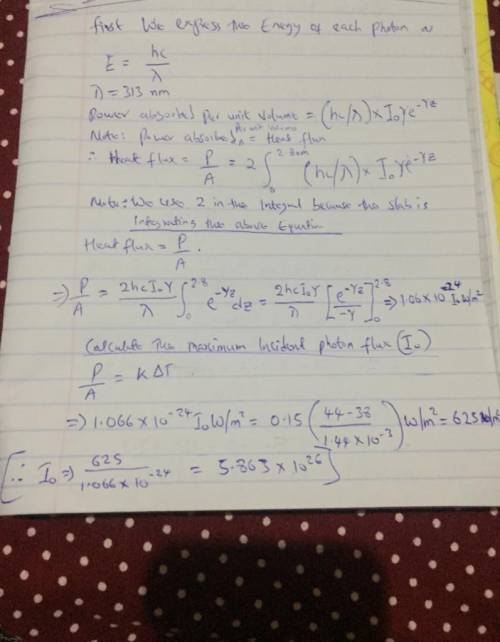
Physics, 08.10.2020 03:01 natalieoppelt
In a test of a new UV-curable polymeric material (with thermal conductivity 0.15 W/(m K)) for dental prostheses, a 2.8 mm thick slab is subjected to monochromatic light with wavelength 313 nm, which is absorbed by the polymeric material according to the Beer Lambert Law of exponential attenuation. The material's surface is exposed to light at z = 0 , the rate at which light is absorbed (with dimensions of photons per unit volume per unit time) is 0 z I e γ γ − , where 0 I is the incident photon flux (with dimensions of photons per unit area per unit time), and 4 1 γ 3 10 m− − = × . (This approximation neglects the temporal decrease in absorption, among other things.) We also assume that all absorbed radiation is converted to thermal energy. (This neglects thermochemical change in the material.) If the two surfaces of the polymeric material (at z = 0 and z = 2.8 mm ) are held at 38°C, what is the largest allowable value of 0 I so that, at steady state, the maximum temperature in the polymeric material does not exceed 44°C

Answers: 3


Other questions on the subject: Physics

Physics, 22.06.2019 03:00, bwheele6791
Arotating space station is said to create “artificial gravity”—a loosely-defined term used for an acceleration that would be crudely similar to gravity. the outer wall of the rotating space station would become a floor for the astronauts, and centripetal acceleration supplied by the floor would allow astronauts to exercise and maintain muscle and bone strength more naturally than in non-rotating space environments. if the space station is 200 m in diameter, what angular velocity would produce an “artificial gravity” of 9.80 m/s^{2} 2 at the rim?
Answers: 3

Physics, 22.06.2019 04:20, pippalotta
Astone is thrown into a pond. what happens to the amplitude of the resulting waves as they get farther from the point where the stone hit the water? explain.
Answers: 3

Physics, 22.06.2019 18:30, sarinaneedshelp01
A1000-kg car is moving at 30 m/s around a horizontal unbanked curve whose diameter is 0.20 km. what is the magnitude of the friction force required to keep the car from sliding?
Answers: 3
You know the right answer?
In a test of a new UV-curable polymeric material (with thermal conductivity 0.15 W/(m K)) for dental...
Questions in other subjects:

Mathematics, 04.07.2020 18:01













